Wine production began about 8,000 years ago and today, more than 60 countries produce over 100 billion gallons of wine per year.
From Chardonnay, Riesling, Pinot Grigio, and Sauvignon Blanc to delicious red nuances of Cabernet Sauvignon, Pinot Noir, Syrah, Malbec, Merlot, and more, many, many more, the world has more than enough wine nuances to satisfy the most demanding palates.
With more than 7 million hectares of land that are used for growing vineyards, the wine industry, along with wine tourism, is booming.
How much wine is produced every year? Which countries are the leaders in such production? What about consumers, who drink more wine – men or women?
In today’s article, we’ll talk about the wine industry, specific wine countries, health benefits, all the numbers, statistics, and data. By the end of the reading, you’ll be a small wine encyclopedia!
Here are the topics we’ll cover today:
- General Wine Statistics
- Wine Industry Statistics
- US Wine Market Statistics
- European Wine Market Statistics
- Australian Wine Market Statistics
- South African Wine Market Statistics
- Argentina Wine Market Statistics
- Organic Wine Statistics
- Canned Wine Market Statistics
- Champagne Statistics
- Wine Consumption Statistics
- Wine Health Statistics
- Wine Tourism Statistics
18 Key Wine Statistics & Data (Editor’s Pick)
- Vineyards took up around 7.3 million hectares of land worldwide.
- There are more than 10,000 original and hybrid varieties of wine grape.
- The global wine market had a revenue of $326.6 billion in 2020.
- In 2020, the US produced more than 700 million gallons of wine.
- EU produces more than 160 million hectoliters of wine every year.
- In 2020, France produced 17% of the total world’s wine production.
- Spain produced 43.2 million hectoliters of wine in 2020.
- Australian wine exports have decreased by 17%.
- More than 50% of vineyards in South Africa cultivate white wine.
- Europe will account for 78% of the global organic wine market.
- The canned wine market grew 80% in 2019.
- Champagne region made a revenue of 5 billion euros in 2019.
- The world consumes up to 250 million hectoliters of wine every year.
- 44% of adults drink at least 2 glasses of wine per week.
- 33% of people drink wine because it makes them happy.
- 2 glasses of white wine per day reduce the risk of heart disease by 25%.
- More than 70% of people choose summer to visit wine countries.
- The pandemic decreased the number of Spanish wine visitors by 70%.
General Wine Statistics
1. More than 7 million hectares of land are used for growing vineyards.
Back in 2020, vineyards took up around 7.3 million hectares of land worldwide. According to the data provided by Statista, most of the world’s wine comes from the Mediterranean region. There, the climate, soil quality, and terrain are perfect for growing grapes.


Source: Statista
2. Wine world has 3 main categories for orientation.
There are many types of wine in the world, but there are 3 main categories people use for orientation. There are red, white, and rose wines. And all three of them can be sparkling and fortified. White wines come with citrusy and refreshing nuances, while red wines have dark fruit flavors. Rose is an excellent light wine perfect for summer. According to the data by Supplements101, sparkling wine is usually served during events and fortified wines are the perfect beverage after a meal.
Source: Supplements101
3. More than a thousand grape varieties are used in wine production.
According to the Crush Wine Experiences and Wine Spectator, about 1,300 grape varieties are used in wine production. The world’s most common and known winemaking grape varieties are Merlot, Chardonnay, Cabernet Sauvignon, Tempranillo, and Airén, a Spanish sherry grape.
Source: Crush Wine Experiences and Wine Spectator
4. Up to 500 grapes are needed to make a bottle of wine.
To make a single bottle of wine, winegrowers need between 400 and 500 grapes. According to the data provided by Supplements101, an average vine will usually produce around 10 bottles of wine. Now imagine how many grapes and vine you need to produce millions of wine bottles that are consumed worldwide on a daily basis!
Source: Supplements101
5. Globally, there are more than 10,000 original and hybrid varieties of wine grape.
Today, there are more than 10,000 varieties of wine grape in the world. However, only a small number of them have achieved widespread popularity and acclaim. According to Winestyr, many of the varieties have been developed by using grafting, as well as other methods used to produce new hybrids.
Source: Wynestyr
6. Italy was the leading producer of wine in 2020.
The Mediterranean region grows most of the world’s wine. France, Spain, and Italy are the top three most significant producers of wine in the world. In 2020, Italy was the leading producer of wine. The country had the highest export volume of wine in that year – 20.8 million hectoliters. The same year, France exported 13.6 million hectoliters, and Spain 20.2 million. The United States and China follow.
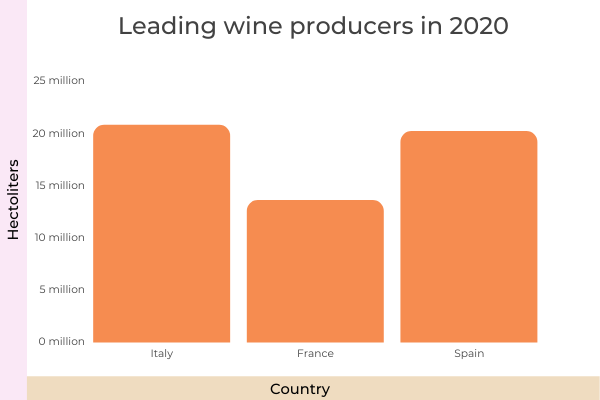

Source: Statista and Newsweek
7. China is the leading market for red wine.
As China is in the top 5 producers of wine in the world, it is also the leading market for red wine. According to Newsweek and their data, the Chinese love this wine not only because of the flavor but also because the red color of the wine is considered to be lucky in Chinese culture. Thanks to that, it is favored by the government.
Source: Newsweek
8. The largest bottle of wine has a capacity of 15 liters.
The largest bottle of wine is the Nebuchadnezzar. It has a capacity of 15 liters of wine. That equals about 20 regular-sized bottles or 100 glasses of wine. According to the data by WineOnMyTime, the larger the bottle is, the less the wine will contact the air remaining in the bottles’ top.
Source: WineOnMyTime
9. Wine is rich in antioxidants.
Antioxidants in red wine are known as polyphenols and they help in protecting the lining of blood vessels in the heart. To get the same amount of antioxidants that come from a glass of wine, a person needs to drink 20 glasses of apple juice or 7 glasses of orange juice. On the other hand, white wine doesn’t provide as many antioxidants.
Source: Beverage Factory
10. The first grapes were grown in Eastern Europe.
According to the data provided by Napa Valley, people have been cultivating grapes for 8,000 years – since before recorded history. The data states that archeologists believe the first grapes were grown in Eastern Europe. From there, the grape spread all around the world.
Source: Napa Valley
Wine Industry Statistics
11. The global wine market is estimated to have a growth of 4.3%.
The global wine market had a revenue of $326.6 billion in the year 2020. The following year, the wine industry made $340.23 billion. According to Statista, it is estimated that the industry will have a CAGR of 4.3% in the 2021-2028 period.


Source: Statista
12. Consumers increase the demand for wine.
The data by Statista stated that consumers have generally increased the demand for wine over the last years. In 2019, people all around the world consumed approximately 244 million hectoliters of wine. That number was an increase from 226 million hectoliters of consumed wine at the turn of the century. With such a high demand for wine consumption, the wine industry is simply blooming.
Source: Statista
13. There are more than 60,000 wine producers in the world.
According to the data provided by Stacker, there are nearly 65,000 wine producers in the world, while about 11,000 of those produces are located in the United States. Of course, almost half of the American producers are in California, as expected. California has more than 4,700 wineries and is the wine capital of the United States.
Source: Stacker
14. Every year, at least 30 million hectolitres of wine are sold in the United States.
The sales of wine in the US are increasing year after year. According to the Wine Institute, in 2016, 35.8 million hectoliters of wine were sold in the United States. A year later, that number increased to 36.3 million hectoliters, and in 2018 to 36.4 million hectoliters. In 2019, 36.6 million hectoliters of wine were sold in the United States. According to the data by Statista, the sales of wine in the US amounted to approximately 435.1 million 9-liter cases in 2020.


Source: Wine Institute and Statista
15. The US produced 9% of the global wine production volume in 2020.
In 2020, the United States produced more than 700 million gallons of wine. That amount equals nearly 9% of the global wine production volume. The country’s wine production is mainly concentrated in California which accounts for up to 90% of the entire US wine production.
Source: Statista
16. The US Wine industry wasn’t really impacted by the pandemic due to the increase in wine drinking.
Unlike other industries which were negatively impacted by the COVID-19 pandemic, the US wine industry had a positive one because people started to drink more wine following the lockdown in 2020. In the beginning, 21% of wine drinkers consumed wine about once a week. The share of wine drinkers at this frequency increased to 25% in the six months of the following lockdown. Due to that, wine producers didn’t really feel the impact of the pandemic on their sales.
Source: Statista
US Wine Market Statistics
17. The US wine market is worth more than $85 billion.
According to Business Wire, the wine market in the United States was estimated at $88 billion in 2020. There is no doubt that the market grew even more in the following year of 2021. The wine market is expected to grow too. The data by Statista stated that this sector is expected to have a high growth rate in the time period of 2022-2025.
Source: Business Wire and Statista
18. The United States exported wine worth $1.36 billion.
Wine Institute reported that the US wine export reached $1.36 billion in 2019. As was expected, California accounted for 95% of the exports. This state had a total volume shipment of 41 million 9-liter cases. That is 372 million liters or 98 million gallons.
Source: Wine Institute
19. Colorado has only 150 wineries, the lowest in the country.
Speaking of California, the wine capital of the United States, there is an impressive number of 4,613 wineries. Washington comes in second with 812 wineries, while Oregon has 809. New York follows with 411 wineries, while Colorado is the state with the lowest number of wineries – there are only 150 of them.


Source: Statista
20. California made a revenue of more than $43 billion in 2019.
In 2019, wines sales in California were estimated at $43.6 billion. According to the data provided by Wine Institute, Californian wineries sent out 241.5 million 9-liter cases for sale in the United States. That number is a 6% jump in value and a 1% decrease in the volume, compared to the previous year of 2018. In 2020, California faced a decrease in wine sales and made a revenue of $40 billion.
Source: Wine Institute
21. Wine sales account for 17% of the total alcohol sales in the US.
For the last years, wine sales have held a share of 17% of total alcohol retail sales in the United States. According to Statista, retail aisles are filled with wine brands like Franzia, Barefoot, and Sutter Home. Barefoot is America’s number one table wine brand. In 2021, this wine brand generated about $664 million in sales in the United States.
Source: Statista
22. Table wine is having a high increase in sales in the last 2 decades.
Speaking of table wine in the United States, sales of such wine have been increasing in the last 20 years. In 2020, the sales were at the highest point. According to the report made by Statists, the sales of table wine in the US amounted to about 334.3 million 9-liter cases.
Source: Statista
23. Table wine was the most purchased wine in 2020.
Statista also reported that table wine was, by far, the most purchased type of wine in the country during the year 2020. Data stated that the sales of table wine were 12 times higher than other types of wine such as sparkling wine and champagne.
Source: Statista
24. Barefoot wine grew more than 19% in value in 2019.
As we already mentioned, Barefoot wine is the most popular and best-selling wine brand in the United States. It is produced in Modesto, California, and in 2019, the brand sold 18 million cases of wine. Barefoot has 17 unique blends of wine such as Cabernet Sauvignon, Chardonnay, Riesling, Merlot, Zinfandel, Shiraz, and more. In 2019, Barefoot grew by 19.2% in value.
Source: Zippia
25. Cabernet Sauvignon was the top-selling wine in 2018.
Cabernet Sauvignon was the top-selling wine variety in the US in 2018. It was sold in the amount worth of $2.57 million of net sales. Chardonnay was in second place with a revenue of $2.54 million, while Pinot Gris was sold in a worth of $1.29 million. Pinot Noir is a variety that is difficult to cultivate, as well as to transform into wine, however, it can develop vegetal aromas that contribute to the complexity of the wine. $1.05 million worth of Pinot Noir was sold in the United States in 2018.


Source: USA Wine Ratings
26. The US produces millions of tons of grapes.
According to the data provided by WineAmerica, the United States has nearly one million acres of grape-bearing land. That includes wine, table grapes, and raisins. Back in 2018, over 7,500,000 tons of grapes were produced in the United States.
Source: WineAmerica
27. California produced 680 million gallons of wine in 2021.
We already mentioned the states with the highest number of wineries, but how about those states with the highest amount of wine production? According to data from 2021, California produced 680 million gallons of wine, Washington 40.7 million gallons, New York 27.9 million, Pennsylvania 12.4 million, and Oregon 11.8 million. Ohio follows with 5.9 million gallons of produced wine, while Michigan had 2.5 million gallons.
Source: World Population Review
28. California accounts for 84% of the total wine production, while Washington only for 5%.
Speaking of wine production in the United States, California accounts for 84% of the share of total wine production. Washington accounts for 5%, New York for 2.46%, and Pennsylvania for 1.5%. Oregon accounts for 1.45% of the total wine production, while other states mentioned in the previous paragraphs account for less than 1%.
Source: World Population Review
29. With more than 800 million gallons of produced wine, the United States is one of the largest wine-producing countries in the world.
According to the data by World Population Review, the United States produces more than 800 million gallons of wine every single year. Thanks to that, the US is one of the largest wine-producing countries in the world. Wine production in the US started in the 16th century when European settlers made wine in Jacksonville, Florida.
Source: World Population Review
30. US wineries has more than 60,000 employees.
It is hard to estimate the exact number of people working in wine production because of the seasonal nature of winemaking and the high number of part-time season workers. However, according to the data by the US Bureau of Labor Statistics, there were more than 64,000 people employed by wineries in 2017. That number is an increase of 153% from 2001.
Source: U.S. Bureau of Labor Statistics
European Wine Market Statistics
31. In 2020, the European wine market surpassed $147 billion.
The data by Statista reported that in 2020, the size of the European wine market exceeded $147 billion. The data also estimated that the market will continue to grow and reach $219 billion by 2025. The market is estimated to see a CAGR growth of 1.13% by that year.
Source: Statista
32. European Union produces more than 160 million hectoliters of wine every year.
According to the data provided by European Commission, the European Union is the world-leading producer of wine. In the time period between 2014 and 2018, the average production was 167 million hectoliters of wine per year. The data stated that this number accounted for 45% of world wine-growing areas, 60% of global consumption, 65% of production, and 70% of exports.


Source: European Commission.
33. Italy, France, and Spain are the leading countries in wine production.
There are 3 European countries that are famous for their wine industries – Italy, France, and Spain. Those countries are the top leading countries in wine production and they account for a significant share of the global vineyard surface area. According to Statista, Spain accounted for 13.1% of the global vineyard surface area in 2020, while France accounted for 10.9%. Italy came in third with 9.8% of the global vineyard surface area. These countries are largely thankful for their Mediterranean climate which has historically made wine-growing flourish in these areas.
Source: Statista
34. Germany produced more than 8 million hectoliters of wine in 2020.
There are a couple of more countries that are market leaders in wine production on the European continent. Those countries are Germany, Portugal, and Romania. In 2020, Germany was the fourth-largest producer of wine in Europe. That year, the country produced 8.4 million hectoliters of wine.
Source: Statista
35. Europe accounts for $427 million in US wine shipments.
According to Wine Institute, the 27 EU countries topped the US wine esports charts in 2019. They accounted for $427 million in shipments. The European wine exports also included markets in Canada with exports worth $424 million, Hong Kong worth $113 million, Japan where wine exports were worth $92 million, and South Korea with wine exports worth $27 million.
Source: Wine Institute
36. France was the world’s top wine exporter in 2020.
European countries are home to some of the world’s most exquisite wines. Besides the fact they are the leading wine-producing countries on a global basis, they are also on the list of the leading exporters of wine. According to Statista, more than 8 billion euros worth of French wine was exported to the rest of the world in the year 2020. Thanks to that, France was the world’s top wine exporter based on the value that year.
Source: Statista
37. European wine exports had an increase between 2010 and 2020.
European imports of wine is relatively constant over the last 10 years. However, European wine exports are a growing trend. The exports increased from 15.88 million hectoliters in 2010 to more than 22 million hectoliters in 2020. That is a rather nice growing rate in a 10-year period.
Source: Statista
38. In 2019, Italy was the leading wine-producing country.
Italy has been leading wine production for a couple of years now. In 2019, the country produced 49.1 million hectoliters of wine. France was in second place with 46.6 million hectoliters, and Spain came third with 40.7 million hectoliters. The US was fourth-ranked with 22.8 million hectoliters of produced wine.
Source: Statista
39. Italy exported 21.6 million hectoliters of wine in 2019.
While France was the leading wine exporter in 2020, Italy had that title in 2019. That year, the country exported 21.6 million hectoliters of wine in volume. Spain wasn’t too far behind with 21.3 million hectoliters, while France was in third place with only 14.2 million hectoliters of exported wine that year. That year, the US exported only 3.6 million hectoliters. Countries with the least amount of exported wine were New Zealand with 2.6 million hectoliters and Argentina with 2.7 million.
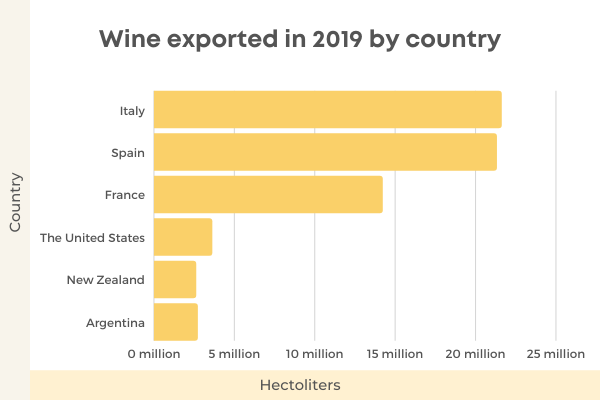

Source: Statista
40. Italy had an up and down wine production in the last 6 years.
According to the data provided by Statista, wine production in Italy has had a rather bumpy ride. In 2015, the country produced 50 million hectoliters of wine. The following year, the production dropped to only 42.5 million hectoliters of produced wine. In 2018, the production jumped again to a high number of 54.8 million hectolitres, only to drop again in 2019 to 47.5 million. In 2020, wine production in volume increased again in Italy. That year, there were 49.1 million hectoliters of produced wine.
Source: Amfori
41. Montepulciano, Sangiovese, and Glera are Italy’s top grape varieties.
Italy is known for its extensive grape varieties. The country is growing more than 400 types of grapes which are used to produce the finest range of wines. When speaking of production, Italy’s top 3 grapes are Montepulciano, Sangiovese, and Glera. Some of the grape varieties that have also seen an increase in popularity and production are Pinto Grigio, Merlot, Trebbiano, and Primitivo.
Source: Vincarta and Italian Wine Central
42. Sangiovese occupies 7.9% of the total vineyards in Italy.
Speaking of specific grape varieties, Sangiovese is the most planted grape variety in Italy with 54,000 planted hectares or 7.9% of the total vineyards. Montepulciano and Glera come as second runners with 27,000 hectares of land or 4% each. Pinot Gris occupies 25,000 hectares or 3.7% of the vineyards, Merlot 24,000 hectares or 3.5%, and Italia variety is planted on 22,000 hectares or 3.2% of the land. Catarratto Bianco and Trebbiano Toscano occupies 21,000 hectares of the land or 3.1% each.
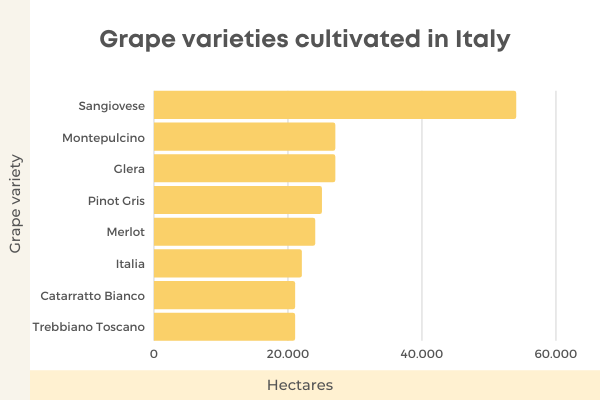

Source: Ogranisation Intenationale de la Vinge et du Vin
43. Germany imported 66 million cases of Italian wine in 2019.
In 2019, Italy exported more than 210 million cases of wine across the world. The top three countries buying Italian wine were Germany, the United States, and the United Kingdom. Germany imported more than 66 million cases of Italian wine worth 1 billion euros. The US was in second place of the Italian imported wine with more than 37 billion cases of wine worth 1,5 billion euros, while the UK imported a bit over 31 million cases of Italian wine worth 761.6 million euros.
Source: Italian Wine Central
44. In 2021, France produced up to 30% less wine.
It is estimated that France produced between 32.6 million and 35.6 hectoliters of wine in 2021, according to the Ministry of Agriculture and Food. The data also stated that those numbers are 24% to 30% lower than in the year before, 2020.
Source: Ministry of Agriculture and Food
45. France produced 17% of the total world’s wine production.
In 2020, France produced about 46.6 million hectoliters of wine. That is around 8% of an increase from the previous year of 2019 when the country produced 42 million hectoliters of wine. That was about 17% of the total world’s wine production.
Source: Aveine
45. France was at the top of the list of wine consumption per capita.
Back in 2019, France was the number one country in terms of wine consumption per capita. According to the data provided by NationMaster, 6.74 liters of pure alcohol were consumed per capita. That number is a 0.9% decrease from the 2018 figure. Portugal, Moldova, and Slovenia also found their way to the top of this list with 6.25, 5.59, and 5.19 million hectoliters of consumed wine.
Source: NationMaster
46. France has 11% of the total number of the world’s vineyard surfaces.
The wine industry in France is presented with 750,000 hectares of the country’s land. According to Aveine, 1 in 5 farms in France is a wine farm. There are about 85,000 wine farms on the French territory. Thanks to this huge vineyards’ surface area, France represents 11% of the world’s vineyards and it is the 3rd largest surface area, right behind Spain and China.
Source: Aveine
47. Southern French region is the most productive wine region.
Languedoc-Roussillon’s vineyards cover 224,000 hectares of the land and extend over 4 departments called Aude, Gard, Hérault and Pyrénées-Orientales. Languedoc wines account for almost 5% of the world’s annual production. According to Aveine, the southern French region produce over 13.6 million hectoliters of wine every year.
Source: Aveine
48. The Languedoc-Roussillon region produces the most organic wines.
The Languedoc-Roussillon region is also known for the highest production of organic wines. Such grape covers 22,000 hectares of vineyards and it accounts for 36% of French production of wines or 7% of world production.
Source: Aveine
49. Burgundy is the richest French region.
French region Provence is the oldest one with 26 centuries behind it. On the other hand and in terms of value per hectare, Burgundy is the richest French region. Burgundy Grand Chu has the highest quotations with nearly 6.25 million euros per hectare. Bordeaux Pauillac is the second runner with 2.2 million euros worth, while in third place is Bordeaux Pomerol with 1.8 million euros of worth.
Source: Aveine
50. Wine industry in France accounts for 15% of the country’s agricultural revenues.
The French wine industry is huge – it produces around 16% of the world’s total wine and employs 142,000 people only in the wine-growing sector. According to the data provided by Business France, wine-growing makes up 15% of France’s agricultural revenues.


Source: Modern Farmer and Business France
51. Champagne is the third favorite alcoholic beverage.
On a yearly basis, France produces 300 million bottles of champagne. This high number of champagne doesn’t include about 1 billion bottles which are already resting and reaching maturity. For growing grapes used in champagne production, France has over 33,000 planted hectares. Worldwide, champagne is the third favorite alcoholic beverage. Back in 2019, French people purchased over 709 billion euros worth of champagne.
Source: Say it With Champers
52. Bordeaux red wine is the most popular wine in France.
The most famous wine region in France is Bordeaux. This region is the reference point for Cabernet Sauvignon which covers 22.5% of Bordeaux’s vineyards. Overall, Merlot covers more land in this region than Cabernet Sauvignon – around 66%. So to conclude, the most popular wine in France is Bordeaux red wine. That includes the mentioned Merlot and Cabernet Sauvignon, along with Cabernet Franc.
Source: Food & Wine
53. Spain uses more than 121,000 hectares for producing organic wine.
Spain has over 1.2 million hectares planted in wine grapes. The country has about 4,000 wineries that produce still wines, sparkling wines, and liqueur. According to the data provided by CaixaBank, organic viticulture covers over 121,000 hectares of land. That is just over 13% of the total area of vineyards. Organic viticulture produces over 441,000 tonnes of wine.
Source: CaixaBank and Foods and Wines From Spain
54. There were 43.2 million hectoliters of Spanish wine produced in 2020.
Data by Global Agricultural Information Network states that Spanish wine production accounts for 23% of the total wine produced in the EU. This country is one of the world’s main producers of wine with 43.2 million hectoliters of wine produced in 2020.
Source: Global Agricultural Information Network and Foods and Wines From Spain
55. Rioja was the most popular wine in Spain in 2016/2017.
In the time period 2016/2017, Rioja was the most sold wine in the terms of volume. More than 2.8 million hectoliters of Rioja wine were sold. Cava wine was a second runner with 1.8 million hectoliters of sales, while La Mancha wine was sold in quantities of 800,000 hectoliters. Rueda wine follows with more than 733,000 hectoliters of sales, Ribera del Duero with 721,000 hectoliters of sales, and Valencia with 507,000 hectoliters of sales.
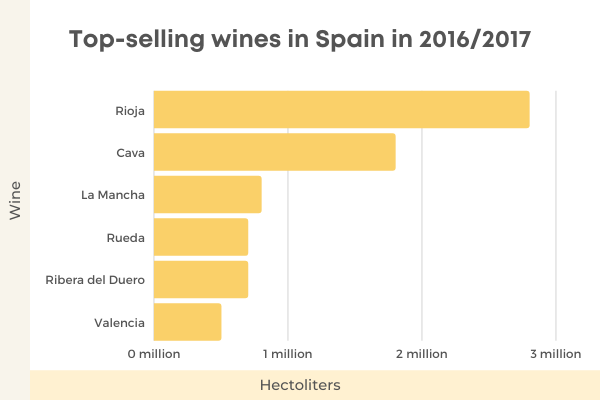

Source: Statista
56. Spanish wine is exported to 189 countries.
In 2019, Spain exported wines worth more than 3 billion euros. As one of the world’s main wine exporters in the terms of volume, Spanish wine is exported to 189 countries. 86 of those countries bought over a million euros in wine in 2020.
Source: Invest in Spain
57. Spain invests 570 million euros in modernizing the wine industry.
Spain has more than 4,000 companies involved in making and producing wine. The wine sector employs over 427,700 people. This high number of employees presents no less than 2.4% of total employment in Spain. Every year, about 570 million euros are invested in modernizing and expanding installations in the country’s wine industry.
Source: Invest in Spain
58. Rías Baixas is the most popular Spanish white wine.
Rioja Gran Reserva is the most famous of all Spanish red wines. This wine ages for a total of 5 years before release. Vinos de Pago is in second place in popularity. This red wine is a relatively new category of Spanish wine and currently, it is cultivated in 14 Spanish vineyards. When speaking of white wines in Spain, Rías Baixas, also known as Albariñ, is the best known and most widely loved white wine of Spain.
Source: Wine Scholar Guild
59. Germany produces 1.3 billion bottles of wine every year.
According to the data provided by Wine International Association, Germany has about 103,000 hectares of vineyard. That number is maybe around one-tenth of the vineyard surface in Italy, France, or Spain. Germany produces 10 million hectoliters of wine on a yearly basis. That is around 1.3 billion bottles.
Source: Wine International Association
60. Germans love their Riesling.
Riesling is the single most widely planted grape variety in Germany – it covers a quarter of the total vineyards in the country. Other white grape varieties such as Weissburgunder, Silvaner, Scheurebe, and Müller-Thurgau account for more than 43% of the country’s vineyard area. Germany has 13 official wine regions and Riesling is the star.
Source: Wines of Germany and Condé Nast Traveler
61. Portugal produced 3% less wine in 2020/2021.
Portugal has 3 major wine-producing regions – Alentejo, Douro-Porto, and Lisboa. The Portuguese wine industry produced 6.3 million hectoliters of wine in 2020/2021. According to the report by GAIN, the Global Agricultural Information Network, that number shows a 3% decrease from the previous season.
Source: Global Agricultural Information Network
62. Portugal has more than 220,000 hectares of vineyards.
According to Wine Tourism in Portugal, the country’s vineyards area is the 8th largest in the world. Portugal has 224,000 hectares planted with grapes. In total, Portugal has 14 wine regions, and all wines have an authenticity seal – white wines, dry wines, rosé, red blends, and sparkling wine.
Source: Wine Tourism in Portugal
63. Romania has a high decrease in wine production.
According to Statista, Romania produced 3.6 million hectoliters of wine in 2020. That was a high decrease in the production from the previous year when the country produced 4.9 million hectoliters. In 2018 and 2013, Romania produced the most wine – 5.1 million hectoliters.
Source: Statista
64. Only 7% of Romanian wine is exported.
Despite the fact that Romania is one of the most productive wine countries in the world, only a small amount of Romanian wine is bought abroad. According to the data by Radio Free Europe, only 7% of the country’s wine production for 2021 will be exported. Romanian wine has a bad reputation due to the country’s past history.


Source: Radio Free Europe
65. Romanian wines earn 35 million euros from the export.
Radio Free Europe reported that Romania currently imports about 65 million euros worth of foreign wines every year. That is about $74 million. When it comes to the country’s exports, Romania earns only 35 million euros or $40 million. Romanian wines are exported and sold to the United States, Canada, Japan, and Switzerland.
Source: Radio Free Europe
Australian Wine Market Statistics
66. Australia has 65 wine regions.
When it comes to Australia, it is ranked 6th in the world in terms of wine production. Australia has 65 wine regions, however, Hunter Valley in Newcastle, Barossa Valley in South Australia, and the Yarra Valley in Victoria alone produce more than 10 million hectoliters of wine every year. Australia grows many wine varieties – from red varieties, most popular ones are Shiraz, Merlot, and Cabernet Sauvignon, while from white varieties, Australia loves to grow Chardonnay, Sauvignon Blanc, and Sémillon.
Source: Statista
67. The Australian wine production industry keeps on growing in value.
According to the data provided by Statista, the Australian wine production industry generates more than 6 million Australian dollars per year. And the industry continues to grow in value. The data also stated that the Australian market presents 22% of Treasury Wine Estates Limited’s total net sales. This company is Australia’s largest wine producer.
Source: Statista
68. Australian wine exports have decreased by 17%.
In 2020/2021, wine exports from Australia amounted to AUD 2.27 billion. According to Wine Australia, the export values for that time period were 24% smaller than in 2019/2020. Also, Australia exported 638 million liters of wine which is 17% less than in the previous fiscal year.
Source: Wine Australia
69. Chinese market accounts for 24% of the Australian exports.
Speaking of exports, Australia’s top destination market was mainland China. The data by Wine Australia stated that the Chinese market accounts for 24% of the Australian exports by value. To put a focus on the domestic market, Australian wine is estimated to account for 474 million liters. That high number makes up 82% of the total sales in volume in 2020/2021.
Source: Wine Australia
70. Shiraz is a variety of choice for Australian wine growers.
According to the data provided by Statista, Australian wine growers mostly cultivate Shiraz grapes. This variety is planted on almost 40,000 hectares of land used for growing the red wine grape. On the other hand, Cabernet Sauvignon is planted and cultivated on less than 25,000 hectares.


Source: Statista
71. South Australia accounts for more than half of vineyard lands.
Wine Australia reported that the total vineyard area in Australia is around 146,244 hectares. South Australia accounts for 52% of those land and New South Wales for 24%. Victoria accounts for only 15% of those wine-growing land.
Source: Wine Australia
72. In 2021, the total amount of winegrape crush was 2.03 million tonnes.
Besides Shiraz, Chardonnay also has its own share of admirers and fans. According to the data by Wine Australia, the total winegrape crush in 2021 was 2.03 million tonnes. Out of that amount, Shiraz accounted for 27%, while Chardonnay for 19%. The total amount of winegrape crush that year was the largest ever recorded.
Source: Wine Australia
73. Australian wine industry has more than 160,000 employees.
The Australian wine industry is rather big. It is estimated that it has 2,156 wineries and about 6,000 grape growers. There are 163,790 full-time and part-time employees across 65 wine-growing regions in Australia. The wine industry annually contributes over $45 billion to the Australian economy.
Source: Wine Australia
74. In 2018, Australia produced 1.29 billion liters of wine.
Back in 2018, the total Australian wine production was estimated to be 1.29 billion liters of wine. This number equals 143 million 9-liter cases – 69 million cases of white wine and 74 million cases of red wine. For comparison, this number of produced wines is 89 million liters (or 10 million cases) lesser than in the previous year 2017.
Source: Wine Australia
75. Australian wine is exported every day to 111 markets around the world.
According to the data provided by Just Wines, 60% of Australia’s wine production, or in numbers, around 2 million wine bottles, are exported every day to 111 international markets. People around the world consume at least 30 million glasses of Aussie wines every single day.
Source: Just Wines
76. White wine accounts for almost 50% of all domestic sales.
The data by Wine Selectors stated that white wine is the most popular type in Australia. Such wine accounts for 45% of all domestic sales. Red wine isn’t that far behind – it accounts for 40% of all domestic sales. Sparkling wine is in third place with 11%.


Source: Wine Selectors
77. Out of 100 grape varieties, Australian consumers prefer 6 of them.
Australia grows more than 100 different grape varieties, however, 6 varieties stand up due to their popularity. When speaking of red wines, Shiraz, Cabernet Sauvignon, and Pinot Noir are the most popular choice of Australians. On the other hand, when it comes to white varieties, they tend to choose Chardonnay, Riesling, and Semillon.
Source: Australian Wine
South African Wine Market Statistics
78. Less than 90% of harvested grapes were used for wine production.
According to the data provided by Wines of South Africa, out of the country’s total annual harvest of a little over 1 billion liters in 2020, 86% was used to produce wine. 4% of the harvested grapes were used for making brandy. 9.7% for distilling wine, and 0.3% for grape juice concentrate and grape juice.
Source: Wines Of South Africa
79. The total number of crushed grapes came with a 7.6% increase.
Speaking of 2020, South Africa crushed 1.34 million tons of grapes. That number is an increase of 7.6% from the previous year 2019. The number of 1.34 million tons of crushed grapes presents the mentioned amount of more than 1 billion liters of produced wine.
Source: WESGRO
80. In 2021, South Africa had 1,4 million tonnes of wine crop.
According to the SAWIS, South African Wine Industry Information & Systems, it was estimated that the 2021 wine crop equals 1,461,599 tonnes. That high number presents a rather nice growth rate of 8.9% than previous years.
Source: South African Wine Industry Information & Systems
81. More than 50% of vineyards cultivate white wine.
At the moment, South Africa has 92,005 hectares of vineyards over an area of 800 kilometers in length. According to the data provided by Wines of South Africa, white grape varieties accounts for 55.4% of the plantings for wine. Chenin Blanc makes up 18.6% of the total amount. Chenin Blanc is a historic South African cultivar and there are registered vineyards that are more than 100 years old.
Source: Wines of South Africa and Wine Enthusiast
82. Cabernet Sauvignon is the most widely planted red variety.
When it comes to red wine varieties, such type of wine accounts for 44.6% of the national vineyard in South Africa. The most widely planted red variety is Cabernet Sauvignon. It covers 10.8% of the total vineyard land. Shiraz comes in second place with 10%, while Pinotage, an indigenous variety, accounts for 7.2% of the vineyard land. Merlot covers 5.9% of the land.
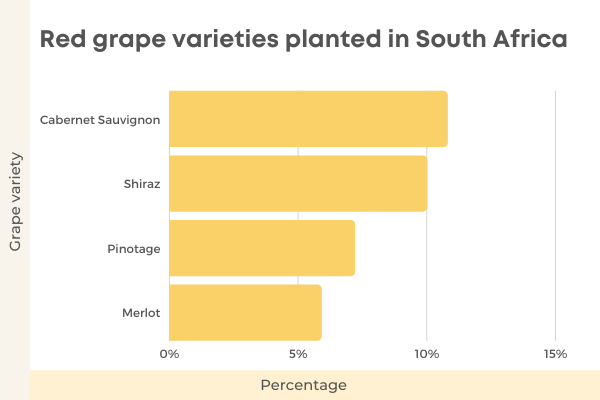

Source: Wines of South Africa
83. South African wine exports had a 6% decrease.
According to the data by Wines of South Africa, the exports of still packaged wines in 2020 reached 137 million liters. That is a decrease of 6% from the previous year. Red wine exports also decreased by 5% to account for 35% of all-natural wines exported.
Source: Wines of South Africa
84. Wine industry in South Africa accounts for 4% of the world’s wine.
Vinpro reported that South Africa is the 9th biggest wine producer worldwide. It produces about 4% of the total world’s wine. The South African wine industry contributes more than R55 billion to the country’s gross domestic product. The industry also employs 269,069 people.
Source: Vinpro
85. Almost 100% of South African wine is sustainable.
According to Wine Paths, more than 95% of the South African wine industry follows sustainable wine growing and winemaking principles. In 2010, the country launched The Seal – a label that certifies a sustainably produced wine bottled within the nation’s borders. A 100% South African wine.
Source: Wine Paths
Argentina Wine Market Statistics
86. Wine production in Argentina is decreasing.
In 2020, wine companies in Argentina produced 10.8 million hectoliters of wine, according to the data provided by Statista. That number shows that wine production in Argentina is still experiencing a decrease in the total number of produced wines. In 2019, the production amounted to 13.02 million hectoliters, while in 2018, it was 14.52 million hectoliters. The highest wine production was in 2010. Then, Argentina produced 16.25 million hectoliters of wine.
Source: Statista
87. Red wine grapes account for 60% of total wine grape production in Argentina.
Even though Argentina’s wine industry is much younger than others, the country has risen and become the 5th largest producer of wine in the world. Currently, Argentina cultivates nearly 500,000 acres of wine grapes. Red wine grapes account for 60% of total wine grape production, while white wine grapes account for about 20% of plantings. The rest of the production goes on pink grape varieties.
Source: Love to Know
88. Malbec accounts for 21% of all wine varieties produced.
Malbec is the most widely planted grape in Argentina. According to the data provided by Love to Know, Malbec accounts for 38% of produced red varieties and 21% of all wine varieties. The data states that Argentinian Malbec has gained a worldwide reputation. However, many other red wines produced in this country are known for their delicious flavors and nuances too.
Source: Love to Know
89. Argentinian wine is exported to more than 160 countries.
In 2020, Argentina exported 395 million liters of wine. That volume was the highest one in the last 12 years. Argentina exports wine to more than 160 countries. The main destinations for Argentinian fractionated wine are the United States, Canada, the United Kingdom, Ireland, Brazil, Paraguay, and the Netherlands. When speaking of bulk wines, Argentina exports to China, Spain, and the Czech Republic, as well as the US and Canada.
Source: Ministerie van Landbouw, Natuur en Voedselkwaliteit
90. Pink-skinned varieties make up 30% of wine grapes grown in Argentina.
The earliest wine industry grapes in the country were pink-skinned varieties. They still make up 20% to 30% of wine grapes grown in the country. This type of wine is meant to be drunk domestically so most pink-skinned varieties never go to the international stage. Pink-skinned varieties are sometimes exported to Japan as a concentrate.
Source: Love to Know
91. The north region has 15,000 acres of vineyards.
According to the data provided by Love to Know, the north region in Argentina has around 15,000 acres of grapes planted. Here, grape cultivation can be found in the provinces of Jujuy, Salta, Tucumán, and Catamarca. In this region, primary grapes are Syrah, Bonarda, Malbec, and Cabernet Sauvignon.
Source: Love to Know
92. Mendoza accounts for 95% of vineyard plantings in Argentina.
The most widely planted region in Argentina is located in the western central part of the country. Cujo or desert country is known for its world-class finest wines. There, the grapes are produced in San Juan, La Rioja, and Mendoza. According to Love to Know, Mendoza is the country’s largest producer of wine. The wine produced there accounts for 75% of Argentina’s vineyards. This region has more than 470,000 acres of vineyards and it accounts for around 95% of vineyard plantings in Argentina.


Source: Love to Know
93. South parts of Argentina plant 10,000 acres of wine grapes.
In the south of Argentina are Patagonia and the Atlantic region. This region plants 10,000 acres of wine grapes and it is the coolest wine-growing region in the country. The main grapes of the region are Syrah, Malbec, Cabernet Sauvignon, Pinot Noir, Chardonnay, Tempranillo, and Bonarda.
Source: Love to Know
94. Malbec covers 45,657 hectares of land.
Malbec is the most important grape variety and it covers 21% of vineyards or 45,657 hectares. Cereza is the second runner and it covers 26,196 hectares or 12% of vineyards. In third place is Bonarda with 18,153 hectares or 8% of the land. Cabernet Sauvignon follows with 14,129 hectares or 7%, Criolla Grande with 13,348 or 6%, and Syrah with 5% or 11,797 hectares. Pedro Gimenez, Torrontés, and Chardonnay cover less than 5% of vineyards each.
Source: South America Wine Guide
Organic Wine Statistics
95. Organic wine market is expected to grow by 10.8%.
In 2020, the global market for organic wine was valued at $11 billion. According to the data provided by Transparency Market Research, the organic wine market is expected to reach $30 billion by 2030. That means that in this decade, the CAGR will be 10.8% per year.
Source: Transparency Market Research
96. Organic wine market is expected to have a 34% increase in consumption.
According to the data by Natural Merchants, it is estimated that a total of 976 million bottles of organic wine are expected to be consumed in 2023. That would be a 34% increase from 729 million bottles consumed in 2018. The data states that currently, Germany consumes the most organic wine, however, France will take over the title by 2023.


Source: Natural Merchants
97. The consumption of organic sparkling wine rose increased by almost 20% in 5 years.
Between 2013 and 2018, the consumption of organic sparkling wine rose increased by 19.1%. According to Natural Merchants, the studies predict an average rise of 8.2% per year in the selected markets by the end of 2023.
Source: Natural Merchants
98. Organic wine consumption is being driven by Europe.
The Drinks Business stated that the majority of organic wine is consumed in Europe. It is estimated that Europe will account for 78% of the global organic wine market in 2022. The data says that the European Union defines wine as organic if it is produced from organic grapes or from oenological techniques and substances authorized for organic wine. Before a winery gains certification for the production of organic wine, it is regularly visited by inspections from agricultural authorities for about 3 years prior.
Source: The Drinks Business
99. Organic wine market is seeing a massive increase.
On a yearly basis, consumers all around the world get roughly 87.5 million cases of organic wine. According to The Drinks Business, people are willing to spend more money on sustainable drinks so the organic wine market has possibilities to grow. For example, between 2007 and 2017, the total organic area under vine has increased by 234% and surpassed 400,000 hectares.
Source: The Drinks Business
100. In the UK, consumers are paying almost 40% more for organic wines.
Additionally, The Drinks Business reported that consumers in the United Kingdom are paying 38% more for a bottle of organic wine compared to non-organic ones. They are also buying more red wine than white/rosé – 60% versus 40% respectfully.
Source: The Drinks Business
101. Red wine is the leading organic wine on a global basis.
Speaking of red organic wine, this product type is the leading segment in global organic wine. According to the data provided by Organic Wine Market, the red organic wine segment accounts for 53.1% of the market in terms of value.
Source: Organic Wine Market
102. Only 1% of organic wine is sold in the United States.
In the United States, organic wine is still a niche market. It accounts for only 1% of wine sold by volume and 2% of wine by value. According to the data by Wines & Vines, domestic and foreign organically grown wines are rapidly increasing. There is no doubt that such wine will reach high levels of popularity in the upcoming years.
Source: Wines & Vines
103. About 60% of vineyards in Bordeaux regions produce organic wine.
Between 50 and 60 million hectoliters of organic wine are produced in France every year. That is about 7 to 8 billion bottles. According to the Natural Merchants, Bordeaux regions produce the best French organic wines. There, at least 60% of vineyards are under sustainable agriculture.
Source: Natural Merchants
104. Almost 20% of Italian vineyards are organically cultivated.
As of 2018, 16.6% of Italy’s vineyards are organically cultivated. That accounts for 26% of the world’s organically farmed vineyards. Besides being popular in Italy, Italian organic wine is exported all around the world too.


Source: Wine Enthusiast and Natural Merchants
105. The number of organic wineries in Spain continues to grow.
In 2020, Spain has more than 100,000 hectares planted with organic vine. Thanks to that, Spain is the country with the largest area dedicated to organic vineyards in the European Union. According to the data provided by Foods & Wines From Spain, the number of organic wineries in Spain has more than doubled in the last years. Back in 2009, there were only 408 such wineries, in 2017, the number jumped to 939, and now, the number exceeds 1,000.
Source: Foods & Wines From Spain
Canned Wine Market Statistics
106. By 2028, the global canned market will have a CAGR of 13.2%.
Grand View Research reported that the global canned wine market size was estimated at $211.4 million in 2020. In 2021, it was estimated to reach $235.7 million. The market is expected to grow at a CAGR of 13.2% from 2021 to 2028. By the end of that period, the global canned wine market will reach $571.8 million.
Source: Grand View Research
107. The canned wine market is a growing trend.
The canned wine market has been one of the fastest-growing sales segments in the wine industry. According to Wall Street Journal and its article from 2019, the canned wine market grew 80% to $90 million during that year. The article stated that the traditional bottle-only perspectives on canned wine are changing and there is no doubt that this market has yet to show its biggest sales and growth.


Source: Wild Goose Filling and Wall Street Journal
108. By 2027, the fortified canned wine market will see a growth in demand too.
According to the data by Wine Business, fortified canned wine is expected to have a CAGR of 10.7% by 2027. There is an increasing demand for fortified wines, especially in North America and Europe. Vermouth is the most demanded wine of that sort.
Source: Wine Business
108. North America accounted for 35% of the canned wine market in 2019.
In 2019, North America led the canned wine market. According to the Wine Business, North America accounted for more than 35% of produced canned wine in 2019. North America is seeing such growth mostly thanks to the substantial consumption among millennials in the United States.
Source: Wine Business
Champagne Statistics
109. In 2018, France accounted for more than half of the global champagne market share.
In 2018, the champagne market size was valued at $5.8 billion. That year, France accounted for more than half of the global champagne market share. Besides, champagne refers to sparkling wine that is produced in the Champagne region in France. According to the data by Allied Market Research, the global champagne market size is estimated to reach $7.4 billion by 2026. That would be a CAGR of 3.2%.
Source: Allied Market Research
110. Champagne region made a revenue of 5 billion euros in 2019.
Forbes reported that the Champagne region accounts for 12% of the volume of sparkling wine in the world. However, it accounts for 33% of the value. The data states that the domestic market for champagne has slightly declined but luckily, exports continue to increase. Forbes stated that in 2019, the turnover was 5 billion euros which was a new record for that French region.
Source: Forbes
111. In 2019, the United States imported the biggest share of champagne.
According to the data provided by CNBC, Champagne houses shipped 297.6 million bottles globally in 2019. The report stated that the highest share of that amount was exported to the United States. The value of the amount delivered to the US was valued at more than $753 million.
Source: CNBC
112. The champagne market is increasing along with the demand for luxury alcoholic beverages.
Allied Market Research stated that the global champagne market growth is driven by the increase in demand for luxury alcoholic beverages of fine quality. According to the available data, the major share of the consumers of this market goes to the top 10% of the earning population.
Source: Allied Market Research
113. Pinot noir is the predominant grape variety.
There are 3 main champagne grape varieties. Pinot noir accounts for 38% of plantings and it is the predominant grape variety. The Meunier is next with 32% of the covered vineyards, while Chardonnay accounts for 30% of plantings and is considered to be the king on the Côte des Blancs.
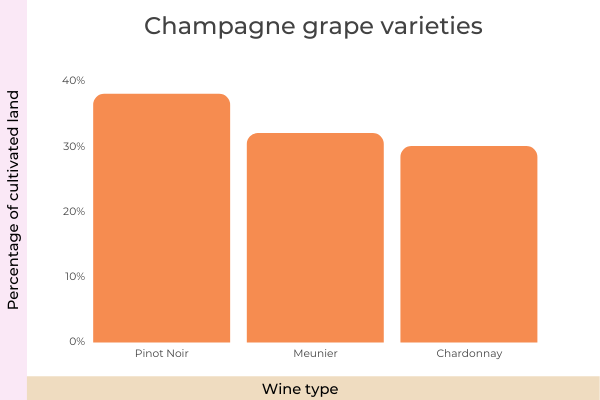

Source: Comité Champagne
114. The UK imports more than 20 million bottles of champagne.
According to the data provided by Comité Champagne, the United Kingdom imports the biggest number of champagne bottles – 21,265,344 of them. The United States is the second runner with 20,838,248 imported bottles. Germany imported 10,122,290 bottles, Belgium 8,994,938, Australia 8,516,583, and Italy 6,944,839.
Source: Comité Champagne
Wine Consumption Statistics
115. The world consumes up to 250 million hectoliters of wine every year.
In 2020, global wine consumption totaled 234 million hectoliters. According to the data by Statista, in the last 2 decades, the consumption figures have been consistent and they usually vary between 226 and 250 million hectolitres per year.


Source: Statista
116. In 2020, American consumers drank 872 million gallons of wine.
According to the report by OIV, the International Organisation of Vine & Wine, Americans drank 872 million gallons of wine in 2020. In terms of consumption, tight after the United States comes France. French people consumed 652 million gallons of wine that year. Germany, Italy, and the United Kingdom all saw growth in wine consumption in 2020. In China, however, overall wine consumption dropped by 17%.
Source: International Organisation of Vine & Wine
117. Aussies drank 5.7 million hectoliters of wine in 2020.
Speaking of specific countries and their wine consumption, in France, people drank 24.7 million hectoliters of wine in 2020, while in Italy, 24.5 million hectoliters of wine were consumed that year. Germany drank 19.8 million hectoliters, the United Kingdom 13.3 million, China 12.4 million, Russia 10.3 million, Spain 9.6 million, and Argentina 9.4 million hectoliters. Aussies also love to consume wine – in 2020, they drank 5.7 million hectoliters of wine.
Source: Statista
118. Almost 70% of Americans choose red wine.
Supplements101 reported that Americans mostly enjoy red wine – 69% of them listed red wine as their preferable wine. Merlot is the most popular type of red wine with 19% of fans. In second place is Cabernet Sauvignon with 18% of people who choose to drink it, and Pinot Noir is in third place with 12%.


Source: Supplements101
119. In 2018, more than half of women were wine drinkers.
According to the data for 2018 provided by Supplements101, about 40% or in specific numbers, 240 million people who have legal drinking age in the United States, drank wine. The data stated that 56% of women and 44% of men are wine drinkers in this country.
Source: Supplements101
120. In Europe, France drinks the most.
When speaking of consumption, France had the highest wine-consuming population amount the European countries in 2020. With the already mentioned number of 24.7 million hectoliters of consumed wine, France was the number one European country in terms of wine consumption.
Source: Statista
121. French men consume more wine than French women.
According to Statista, French men drink more wine than women. The data states that 74.7% of men in France consume wine, compared to 60.5% of women who do the same. However, men consume more wine than women for years now – in 1980, 90.8% of men and 73.4% of women consume wine. In 2000, the number dropped to 76.1% of men and 59.2% of women.
Source: Statista
122. Aussies drank more than 13 liters of white wine in 2018.
In 2018, an average of 13.79 liters of white wine per person were consumed in Australia. When speaking of red wine, 10.59 liters of such wine were consumed that year per person. Additionally, 3.96 liters of other varieties of wine were consumed per person in Australia in 2018.
Source: Statista
123. China is the sixth leading country in the terms of wine consumption.
The Chinese population consumed around 1.24 billion liters of wine in 2020. Thanks to that, the country is the sixth leading wine consumer on a global basis. According to the data by Statista, the highest wine consumption in China was reached back in 2017.
Source: Statista
124. Chinese demand for wine is constantly increasing.
China’s wine market is the world’s third-largest one when speaking of revenue. The country is right after France and the United States. The demand for wine in China is rapidly increasing and back in 2019, the per capita consumption average was 1.1 liters of wine. That was a 20% increase compared to 2012. Red wine is the Chinese favorite wine.
Source: Statista
125. Canadian wine market expects to have a revenue of more than 13 billion in 2022.
In Canada, annual wine consumption is around 447 million liters. Domestic Canadian wine is the dominant consumers’ choice, however, imported wine accounts for more than 70% of wine consumption. The data by Statista stated that retail sales of wine in Canada are expected to exceed 13.2 billion in 2022. This data also showed that consumers in Saskatchewan purchase the least wine, while those in Quebec the most.
Source: Wine Australia and Statista
126. More than half of seniors drink a couple of glasses of wine per week.
SurveyMonkey reported that around 75% of adults drink wine. 44% of adults drink at least a couple of glasses per week. When we’re talking about generations, 51% of adults aged between 30 and 44 drink a couple of glasses of wine every week compared to 53% of adults aged 60 and older who do the same.
Source: SurveyMonkey
127. For 47% of people, wine is a stress reliever.
Wine is popular because of its taste and the way it makes people feel. According to the study by SurveyMonkey, 63% of people drink wine for the taste, 47% of them drink it because the wine presents a stress reliever, while 41% of people love to drink this beverage because it pairs well with food. 33% of people drink wine because it makes them happy.
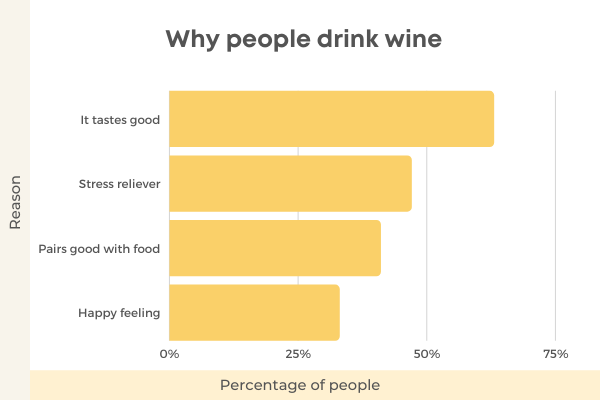

Source: SurveyMonkey
128. Only 10% of people will pay more for wine.
Money is an issue when it comes to wine because quality is often linked to higher amounts of money. According to the study conducted by SurveyMonkey, 3% of people are willing to spend $100 or more on a bottle of good wine. On the other hand, 7% of people are willing to give anywhere between $50 and $99.
Source: SurveyMonkey
129. Income or age doesn’t impact the interest in fancy wines.
Not many people would pay a lot of money for a bottle of wine and thanks to that, interest in fancier wines barely changes as people earn more money or get older. Only 7% of those who are aged 45 or more, would spend $50 or so on a bottle, while only 13% of those earning a household income of $100,000 or higher would spend $50 or more on wine.
Source: SurveyMonkey
130. People who drink wine are considered relaxed and sophisticated.
As with any other drink, consuming wine gives people a certain reputation too. According to the data provided by SurveyMonkey, the top adjectives that come to mind for wine drinkers are health-conscious (18%), outgoing (25%), sophisticated (38%), and relaxed (59%).
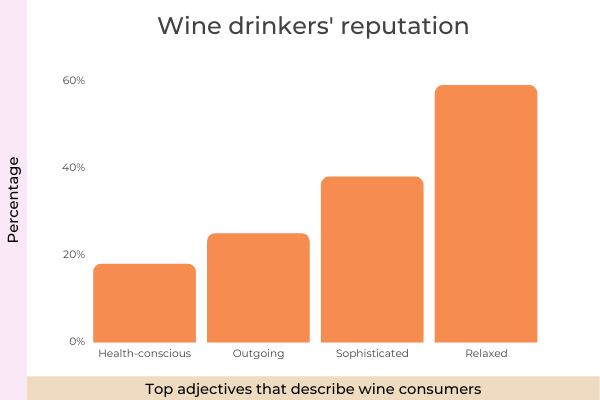

Source: SurveyMonkey
Wine Health Statistics
131. Red wine increases HDL cholesterol levels.
Healthline reported that regular consumption of red wine can help increase good HDL cholesterol levels. Good HDL cholesterol reduces the risk of cardiovascular diseases and red wine is an excellent way to maintain health. According to Healthline, daily consumption of 1 to 2 glasses of red wine may lead to increased HDL levels. The study showed that people who consumed red wine experienced an 11% to 16% HDL increase compared to those that drank water or some other beverage such as water with grape extract.
Source: Healthline
132. Red wine improves sleep too.
Speaking of red wine, Annals of Internal Medicine reported that red wine can lower cardiometabolic risk in those people who have type 2 diabetes. People who were moderately drinking wine not only lowered the cardiometabolic risk but also improved the quality of their sleep.
Source: Annals of Internal Medicine
133. Moderate drinking can lower the risk of depression.
According to the data by NCBI, drinking wine lowers the risk of depression. Drinking 2 to 7 glasses of wine per week can lower the risk of incident depression – so the wine does make you happy even though it can’t cure everything. However, the consumption should be moderate. Those who drink too much wine may actually develop a higher risk for the same illness.
Source: NCBI
134. Red wine consumers have a 50% smaller risk to die from a heart attack.
With about 600,000 people dying from heart disease in the United States every year, the study showed that moderate red wine consumption can reduce the risk of death by heart disease and heart attack by 30% to 50%. Due to that, red wine has become an increasingly popular drink among health-conscious consumers.


Source: Science Direct
135. White wine is rich in antioxidants.
Stories about red wine benefits are known to all – but what about white wine? White wine contains antioxidants such as epicatechin, quercetin, and resveratrol which contribute to weight loss. According to data provided by Wine Country Gift Baskets, 1 or 2 glasses of white wine per day can positively contribute to the weight loss journey.
Source: Wine Country Gift Baskets
136. Two glasses of white wine reduce the risk of heart disease by 25%.
According to Wine Country Gift Baskets, white wine is just as good for the heart as red wine. The grapes’ skin is high in antioxidants and nutrients and 2 glasses of white wine per day can reduce the risk of heart disease by at least 25%.
Source: Wine Country Gift Baskets
137. Wine protects the lungs.
White wine keeps the lungs healthy. It contains all the necessary nutrients which keep the lung tissues healthy and working well. Red wine also benefits the lungs, however, white wine has proven to be much stronger. According to the study, white wine has antioxidants that stop the development of molecules called free radicals that destroy lung tissue.
Source: Wine Country Gift Baskets
Wine Tourism Statistics
138. More than 70% of people choose summer to visit wine countries.
Are seasons important when visiting wine countries? Well, they are for most people. According to Great Wine Capitals, 70.4% of tourists prefer visiting wine countries in the summer. Fall is a season of choice for 15.3% of people, while spring is perfect for 8.3% of visitors. Winter is the least favorite season for wine tourism – only 2.7% of tourists choose to tour wine countries during winter. 3.4% of tourists state that the seasons are not important to them when visiting wine countries.
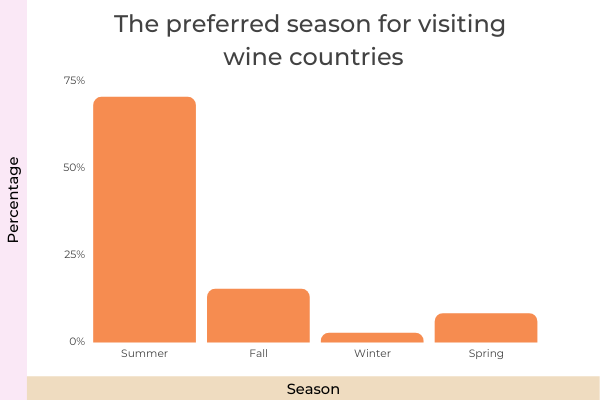

Source: Great Wine Capitals
139. Younger people aren’t that interested in wine tourism.
According to the data provided by Great Wine Capitals, men are more into wine tourism than women. In the terms of consumers’ age, people aged between 36 and 55 visit wineries the most. Those aged between 18 and 35 rarely visit wineries and are not interested in wine tourism as much as other (older) generations.
Source: Great Wine Capitals
140. Cape Town started with wine tourism in 1990.
Great Wine Capitals reported that Cape Town has one of the oldest wine tourism traditions – since 1990. Bordeaux also realized the huge potential of wine tourism early on and started its activities in 1990 too. Mainz, Napa, and Porto started with such tourism around 1995, while Florence and Bilbao-Rioja did so between 1995 and 2000.
Source: Great Wine Capitals
141. Wine tourism improves the wine industry’s value and brand image.
68.9% of wineries reported the improvement in their businesses and branding thanks to wine tourism. Around 61.9% of wineries said that wine tourism increased their revenue, while 53.8% of them stated that it helped them with brand positioning. 52.8% of wineries feel that wine tourism helps the tourism industry in their community. 35.6% of them feel that wine tourism opens up employment opportunities.
Source: Great Wine Capitals
142. Marketing is important for wine tourism.
Tourist information offices are a great way for wine promotion. 68% of wineries work with such offices to promote their wine tourism. However, 63.7% of wineries love to host wine-tasting events to show tourists a glimpse of what they’ll get when visiting their wineries. 41.2% of wineries use social media for marketing while 52.2% of them participate in wine fairs to boost promotions.


Source: Great Wine Capitals
143. More than 70% of wineries offer guided visits.
Wine companies need to offer interesting events and packages. The Great Wine Capitals reported that 83.1% of wine companies offer wine tasting events, while 74.9% of them offer guided visits. 39.9% of wineries include restaurants in the package, while 17.1% host exhibitions on a regular basis. According to the available data, 20.3% of wineries host cultural, social, and sports activities to enhance entertainment.
Source: Great Wine Capitals
144. Italian wine tourism had revenue of 2.65 billion euros in 2019.
Wine tourism is rather popular in Italy. According to Statista, in 2018, Italy made a revenue of 2.5 billion euros with 14 million arrivals and visitors in the wineries and wine companies. In 2019, the numbers increased – the country made 2.65 billion euros thanks to 15 million tourists.
Source: Statista
145. Wine tourism in Australia had 5.5 million visitors in 2020.
In 2020, more than 5.5 million visitors went to wineries in Australia and during their time in the country, they spend $5.9 billion. According to the data provided by Wine Australia, only 2% of Aussies visit wineries, while 1 in 8 international visitors visit wineries and enjoy wine tourism.
Source: Wine Australia
146. French wine tourism had a 30% growth.
France is an all-time favorite destination for wine tourism. Since 2009, wine tourism has seen a 30% growth and in 2016, France had 10 million wine tourists with a revenue of 5.2 billion euros. According to Visit French Vine, wine tourism and events are attracted to domestic visitors (58%) as much as foreigners (42%).
Source: Visit French Vine
147. The pandemic decreased the number of Spanish wine visitors by 70%.
COVID-19 has drastically impacted Spanish wine tourism. The pandemic decreased the number of wine tourists in Spain by more than 70% in 2020. Before this global health crisis, Spain had a rather nicely developed wine tourism. 52.3% of the winery visitors were women compared to 47.7% of men.
Source: Entre Vinos y Pagos
148. Argentina had 245 wineries included in wine tourism in 2017.
Back in 2017, Argentina had 245 wineries offering wine tourism attractions. 165 of them were located in the Central-West region. New wine regions that include the provinces of Buenos Aires, Córdoba, Río Negro, Entre Ríos, and Chubut accounted for 36% of wine tourism in Argentina that year.


Source: Statista
149. Baby boomers are frequent visitors of Californian wineries.
In California, 53.7% of wine tourism visitors are women compared to 46.3% of men. When speaking of generations, Baby boomers account for 39.5% of visits, Gen X for 21.9%, and Millennials account for 36.1% of the total number of wineries’ visitors.
Source: Travel Agent Central
150. COVID-19 pandemic impacted more than 30% of wineries.
Wine tourism was badly impacted by the COVID-19 pandemic. The data by Statista stated that more than 32% of wineries surveyed lost between 50% and 80% of their revenue from wine tourism in 2020. On the other hand, only 6% of wineries saw increased revenue from wine tourism that year.
Source: Statista
To Wrap It Up
With more than billions of gallons of wine produced every single year, it doesn’t come as a surprise that the world surely loves its wine. Besides the fact that such an industry generates billions of dollars of revenues on a yearly basis, moderate wine consumption also contributes to a healthy body and lifestyle. Even though the COVID-19 pandemic has had a negative impact on wine tourism in many countries, wine consumption at home has definitely increased during this period of the pandemic so the industry wasn’t impacted that much.




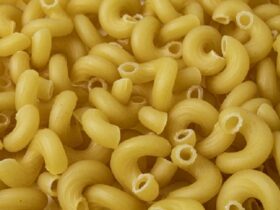
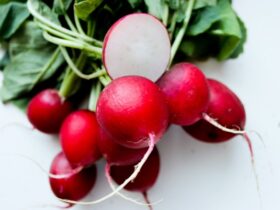











Leave a Reply